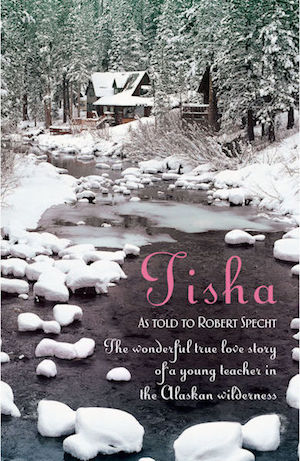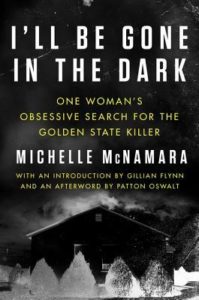Last week I sort of breezed over the news that the a suspect identified as the Golden State Killer has been arrested. Not this week! I’ve got a bunch of Golden State Killer links, plus some other odd news from the world of nonfiction. Let’s go!
 Sponsored by Bas Bleu Books and Gifts
Sponsored by Bas Bleu Books and Gifts
In 1927, nineteen-year-old Anne Hobbs arrived to Chicken, a tiny gold-mining community in the Alaskan territory, to teach school. Hobbs forged friendships with many of the villagers, but her affinity for some of the local Indians was a source of much conflict, especially when she began to fall in love with a “half-breed” miner. Hobbs forged ahead, staying strong in the face of life-threatening hardships and soul-crushing prejudices, opening her home and heart to those who needed it most. Captivating and inspiring, this true story has become an unexpected favorite of readers of all ages!
The Golden State Killer: A Deep Dive
As you may (or may not) recall, the Golden State Killer is just one nickname for a serial rapist and murder connected to more than 50 sexual assaults and 12 murders in California between 1974 and 1986.
 He came back into the public eye this year after the publication of I’ll Be Gone in the Dark, a book by journalist Michelle McNamara chronicling her search for the killer. McNamara died in 2016, and so the book was published posthumously by her husband, comedian Patton Oswalt, and her research assistants. You can also read many of her news stories on the case in this archive at Los Angeles Magazine – “In the Footsteps of a Killer” is a great read.
He came back into the public eye this year after the publication of I’ll Be Gone in the Dark, a book by journalist Michelle McNamara chronicling her search for the killer. McNamara died in 2016, and so the book was published posthumously by her husband, comedian Patton Oswalt, and her research assistants. You can also read many of her news stories on the case in this archive at Los Angeles Magazine – “In the Footsteps of a Killer” is a great read.
Last week, authorities in California arrested a suspect, a 72-year-old former police officer that they connected to the crimes using DNA evidence. But not DNA evidence they collected in the usual ways – they used a genealogy website called GEDmatch to match DNA from the crime scenes to a relative of the killer, then used other evidence to confirm the suspect.
Wired has a great article about how that all worked. It’s not quite as nefarious as the police looking directly at your DNA from a testing service like 23andMe, which explicitly doesn’t allow law enforcement access. In this case, people could voluntarily submit already-completed DNA profiles to the site, which allowed the police to create a fake profile with DNA from a GSK crime scene. According to the Washington Post, the DNA investigators had was used to find the killer’s great-great-great grandparents, which were the start of 25 family trees tracking thousands of relatives to the GSK. Fascinating!
There’s a ton of interesting reporting happening around this case. A few other articles to peruse:
- ABC News reports on two key ideas that helped open up the case – duplicate rape kids, and the genealogy website.
- Despite arresting a suspect, there are still a lot of questions on the case. Chief among them is why the GSK shifted his attacks to the south midway through the spree.
- One thing I have not enjoyed about this reporting are the stupid headlines suggesting that the GSK’s ex-fiancée, is somehow to blame because she broke up with him. Yeah… no. That’s dumb and sexist and gross. This column in the Boston Globe gets at everything that’s pissing me off about this narrative.
- On the plus side, the HBO documentary series based on McNamara’s book has been officially greenlit, meaning it’s in production and on the way. Yay for that.
Bits and Pieces
And finally, a couple of odd little nonfiction-adjacent stories that came across my feed this week:
Maria Konnikova (author of Mastermind: How to Think Like Sherlock Holmes) has delayed her next book, all about the world of professional poker, because she’s become so good at poker that she wants to keep playing. I love stunt memoirs – books about people really trying a new thing, or radically changing their life for a period of time – so the idea that someone working on one got so good they just gave up on that whole book thing makes me laugh.
Sarah Carlson, a former CIA analyst hoping to write a book about her experience, has been prevented from publishing the book by the CIA… after they originally said she could. From 2008 to 2015, Carlson worked in the CIA’s Counterterrorism Center, “analyzing terrorist groups’ plans and patterns of attack outside their Mideast and North African home courts.” According to the lawsuit, the book was approved twice by the CIA’s approving agency, but has now been deemed to reveal classified material. Lawsuits are ongoing.
Susan Orlean has a new book coming out… how did I miss this? The Library Book, out in October, is about at 1986 fire at the Los Angeles Public Library that “destroyed or damaged more than a million books.” I’m in.
That’s it for this week. Don’t forget, Book Riot has an awesome giveaway going on right now – follow this link to be entered in a drawing for 15 of the year’s best mystery/thrillers!
I’ll be back in your inboxes next Friday with some new nonfiction to look for this month. Until then, find me on Twitter @kimthedork, and co-hosting the For Real podcast here at Book Riot. Happy reading!